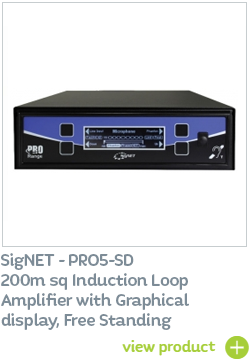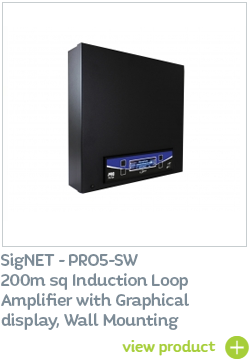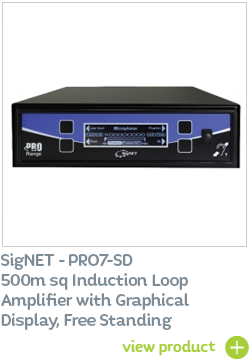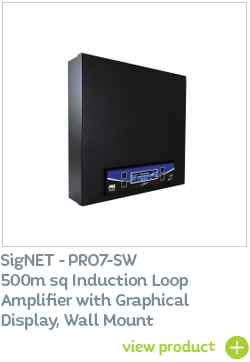Signet launches new Pro Series Loop Amps
Signet launches new PRO Series induction loop D-class amplifiers for professionals.
Available now from CIE, the Signet Pro Series is the latest addition to their professional Induction Loop Amplifier range.
Hearing loss affects 1 in 6 of the population therefore it is a top priority to provide assistive listening technologies such as hearing loop systems for accessibility and inclusivity.
Main Features of the SigNET Pro Range:
-
D class amplifier technology for maximum efficiency and higher power
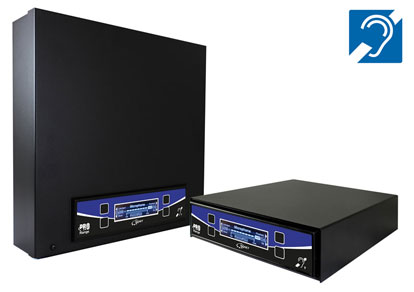 output
output - Digital control & status display
- Choice of wall mount and desktop mount formats
- Choice of single and Dual Phase Shifting for signal overspill control
- Built-in Dual Phase Shifting technology allows for much greater control of signal overspill and improved privacy
The SigNET Pro Series Range:
Product |
Mounting Format |
Max. Area Coverage |
Outputs |
|---|---|---|---|
| PRO5-SD | Free standing | 200m² | Single |
| PRO5-DW | Wall mount | 200m² | Dual |
| PRO5-SW | Wall mount | 200m² | Single |
| PRO7-SW | Wall mount | 500m² | Single |
| PRO7-SD | Free standing | 500m² | Single |
| PRO7-DW | Wall mount | 500m² | Dual |
| PRO7-DD | Free standing | 500m² | Dual |
| PRO11-SW | Wall mount | 1000m² | Single |
| PRO11-SD | Free standing | 1000m² | Single |
| PRO11-DD | Free standing | 1000m² | Dual |
Why do we need Assistive Listening Systems?
Since the revision to BS 8300 Code of Practice in 2018, Assistive Listening Systems are now legally required in any public place that hearing impaired members of society is given the same opportunity to hear messages, speakers, or any other sound as clearly as anyone else.
These standards were introduced to not only ensure quality, but to discourage facility operators from installing bad quality systems which do not function as intended in an attempt to comply with legislation whilst reducing costs.
What is the BS 8300 Code of Practice?
BS 8300 is a British Code of Practice that sets out the requirements of how buildings should be designed, constructed and maintained to meet the needs of disabled people as well as create an accessible and inclusive environment for them.
BS 8300 is in place to ensure everybody has access to enter, to use and to exit a built environment open to the public equally. This is aimed particularly at the diasbled, elderly or those less able to stand.
Featured Products
What types of assistive listening technologies are there?
There are three main assistive listening technologies:
Each of these have positive and limiting factors which suit specific applications.
What are Hearing Induction Loops?
A hearing loop or induction loop works by providing a direct link to a sound source for example a microphone, television or sound system. The sound is picked up by a microphone, converted to a magnetic signal by amplifier which is then transmitted towards a user via hearing loop aerial. The magnetic signal is picked up by the Telecoil within a users hearing device this means the user will then be able to hear with clarity.
What are Infrared Assistive Listening Systems?
Infrared Assistive Listening Systems are an audio technology with supports improved hearing and communication for people with a hearing impairment.
Developed as a wireless alternative to Induction Loop systems, Infrared assistive listening systems work by converting an audio source into infrared light; this is then wirelessly tansmitted to users via an infrared signal. The infrared receivers (worn by users) then convert this light back into audio, which provides a clear and simple listening experience for hearing impaired audience members.
IR systems are ideal for when a sound source needs transmitting to multiple receivers, when confidentiality is required in small spaces or when ambient noise needs reducing.
What are RF Assistive Listening Systems?
RF assistive listening systems provides sound reinforcement to hard-of-hearing persons with, or without, hearing aids.
In an RF assistive listening system, the sound is transmitted via radio frequency to a receiver and headphones. It may also deliver the sound directly to a receiver connected to a cochlear implant or telecoil hearing aid. The RF system can be used in small or large spaces, however it is not ideal in situations where privacy is necessary because the signal isn’t contained like an IR system. People often use this low-cost system in: classrooms, public meeting spaces, churches, conference rooms, and nursing homes.


